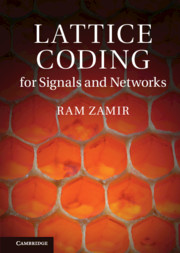 Lattice Coding for Signals and Networks
Lattice Coding for Signals and Networks Book contents
- Frontmatter
- Dedication
- Contents
- Preface
- Acknowledgements
- List of notation
- 1 Introduction
- 2 Lattices
- 3 Figures of merit
- 4 Dithering and estimation
- 5 Entropy-coded quantization
- 6 Infinite constellation for modulation
- 7 Asymptotic goodness
- 8 Nested lattices
- 9 Lattice shaping
- 10 Side-information problems
- 11 Modulo-lattice modulation
- 12 Gaussian networks
- 13 Error exponents
- Appendix
- References
- Index
8 - Nested lattices
Published online by Cambridge University Press: 05 August 2014
- Frontmatter
- Dedication
- Contents
- Preface
- Acknowledgements
- List of notation
- 1 Introduction
- 2 Lattices
- 3 Figures of merit
- 4 Dithering and estimation
- 5 Entropy-coded quantization
- 6 Infinite constellation for modulation
- 7 Asymptotic goodness
- 8 Nested lattices
- 9 Lattice shaping
- 10 Side-information problems
- 11 Modulo-lattice modulation
- 12 Gaussian networks
- 13 Error exponents
- Appendix
- References
- Index
Summary
The magic of lattices in modern communication and information theory is their potential for coordinated operation. Many of the coding techniques which we shall see from this point on, shaping, binning and alignment, are based on the interplay between two (or more) lattices. These lattices generate a code for a single communication link, or a system of codes for a distributed communication setup.
This short chapter provides the necessary background on nested lattices. It will be used in Chapter 9 for lattice-shaped modulation over the AWGN channel, and extended in Chapters 10–12 to multi-terminal setups and joint source-channel coding.
Imagine a ruler with a coarse scale and a finer scale, numbered on a binary basis: the coarse scale is numbered by the most significant bits (MSBs), while the least significant bits (LSBs) identify the fine markings in between; see Figure 8.1. A set of fine markings between two coarse markings – which share the same MSBs – can be thought of as a “finite codebook.” The union of all such finite codebooks gives the whole ruler. An alternative partition of the ruler is into sets of markings with the same LSBs. Each such coset is a shift of the coarse scale by a point in the fine scale, and the union over all such cosets gives again the whole ruler.
Information
- Type
- Chapter
- Information
- Lattice Coding for Signals and NetworksA Structured Coding Approach to Quantization, Modulation and Multiuser Information Theory, pp. 178 - 196Publisher: Cambridge University PressPrint publication year: 2014